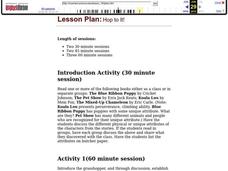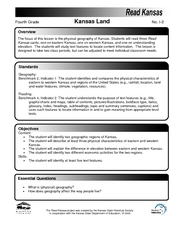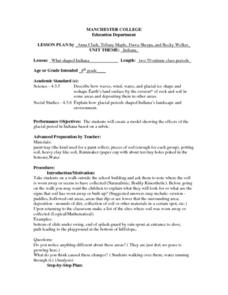South Gloucestershire Council
Animal Classification: A Collaborative Sorting Activity for Key Stages 2 & 3
Introduce the logic behind a dichotomous key or administer a group performance assessment with a fun and challenging classification lesson. With explicit instructions for the teacher and for collaborative groups, as well as engaging...
Curated OER
Understanding "The Stans"
Learners explore and locate "The Stans" in Central Asia to create, write and illustrate maps, graphs and charts to organize geographic information. They analyze the historical and physical characteristics of Central Asia via graphic...
Curated OER
What Do Koalas Need to Survive?
First graders take a field trip and examine the Koala and his habitat. In this Koala lesson, 1st graders read Possum Magic and discuss the foods of Australia. Students view the habitat of a Koala and record what it eats, its...
Curated OER
Crustacean Critters
Students explore the habitats of hermit crabs. In this crustacean lesson, students discover what animals need to survive. Working with live hermit crabs, students explore how hermit crabs have adapted to their habitats.
Curated OER
Mammal Morphology - Bats, People, and Other
For this physical characteristics worksheet, students compare bats and humans by putting a + sign in the chart for whether or not bats and humans have the same characteristics. Students do this for 17 characteristics and answer 3 questions.
Curated OER
Hop To It!
Students explore grasshoppers. In this grasshoppers lesson, students measure the jumping distance of live grasshoppers. Students then record the jumping distance of people in their group. Students record the distances and...
Curated OER
Animal Signs Word Search
Although this animal and environment word search has little educational merit, it may serve as a vocabulary review tool for scholars new to these terms. The words students must find include camouflage, interdependent, muskrat, food...
Curated OER
Shark Quiz
In this sharks activity, students complete 10 multiple choice questions about the Great White Shark and its physical characteristics, diet, life span, and more.
Curated OER
Gorilla Quiz
In this instructional activity, students complete 11 multiple choice questions about gorilla's physical characteristics, life span, and weight. Answers are provided.
Curated OER
Water Snails
Learners study water snails. In this water snails lesson, students research the habitats of water snails. After conducting research, learners investigate water snails in their habitats and generate scientific observations.
Curated OER
Naked to the Eye
Sixth graders study microorganisms. For this microorganism lesson, 6th graders explore the form and function of these organisms. Students use magnification during experiments on bread.
Curated OER
Kansas Land
Fourth graders discover the geographic regions of Kansas. In this geography lesson, 4th graders explore the different regions of Kansas and determine how the different geography affects daily life in Kansas.
Curated OER
If These Walls Could Talk: Seeing a Culture Through Human Features
Pupils read Talking Walls and discuss the walls presented and their importance to the culture. In this geography lesson, students locate and label each country/continent discussed in the book on a world map. Pupils take a walk and point...
Curated OER
Mountain Magic: Identifying the Basic Physical Characteristics of Mountains
Students read about and identify on maps the physical characteristics of mountains. In this mountains lesson plan, students also write about the characteristics using personification.
Curated OER
Mammal Morphology: bats and people
In this mammals activity, students compare and contrast the physical characteristics of bats and people by filling out a chart. Students complete 17 rows in the chart and answer 3 short answer questions.
Curated OER
Island Inquiry: Based on the Northern Mariana Islands Quarter
Students research two physical and/or human characteristic topics of the Northern Mariana Islands in groups of four students. In this social studies lesson, students analyze how to write magazine articles and research the two topics...
Curated OER
My Science Box
Students investigate snails and their physical and behavioral characteristics. In this investigative lesson students create a pie chart to show the results of their findings.
Curated OER
Earth's Land and Water
Learners describe physical characteristics of bodies of water and landforms. In this land and water lesson plan, students model land and water with modeling clay and also discuss why people live near bodies of water.
Curated OER
Marshland Ecosystem
Students classify animals based on their physical characteristics and eating habits. In this animal identification lesson plan, students investigate the life forms shown on a Parisian ceramic basin, and discover ecosystem the...
Creative Chemistry
Reactions of Group 1 Metals With Water
For this elements worksheet, students complete a graphic organizer comparing lithium, sodium, and potassium observations. Then, they determine how these elements react with water. Students complete three fill-in-the-blank questions.
Curated OER
Factors That Shaped Indiana
Fourth graders construct a model of Indiana which displays the effects of the glacial period on the state's physical structure. Students work in groups to plan and execute their model based on an established rubric.
Curated OER
ESOL Interpersonal Communication
Students examine vocabulary words pertaining to the physical and personal characteristics of self, family, and others. They pronounce the vocabulary words and determine comparative adjectives for the words that are polite. They write...
Curated OER
Unknown Element Project
High schoolers work with a partner to determine the identity of an unknown element based on given descriptions. Groups use classroom textbooks, encyclopedias, and science internet sites to identify their unknown element then write a...
Curated OER
Project Geode
Students predict the appearance of a geode's internal structure based on its mass and density. They form a hypothesis based on the data they collect. They also identify common minerals found in Illinois.

























